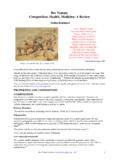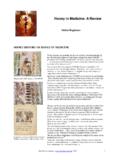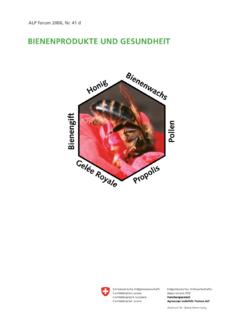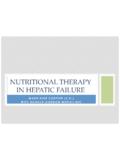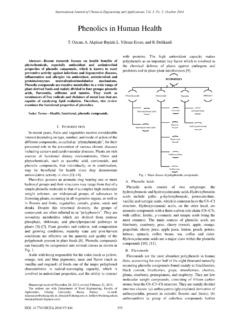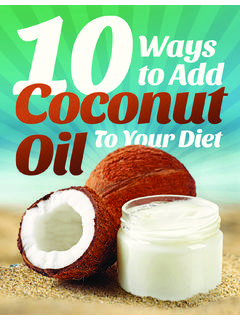Transcription of Honey for Nutrition and Health: a Review - bee …
1 After: American Journal of the College of Nutrition , 2008, 27: 677-689. Honey for Nutrition and health : a Review Stefan Bogdanov, PhD, Tomislav Jurendic, Robert Sieber, PhD, Peter Gallmann, PhD1. Swiss Bee Research Centre, Agroscope Liebefeld-Posieux Research Station ALP, Berne, Switzerland Key words: Honey , Nutrition , composition, glycemic index Due to the variation of botanical origin Honey differs in appearance, sensory perception and composition. The main nutritional and health relevant components are carbohydrates, mainly fructose and glucose but also about 25 different oligosaccharides. Although Honey is a high carbohydrate food, its glycemic index varies within a wide range from 32 to 85, depending on the botanical source. It contains small amounts of proteins, enzymes, amino acids, minerals, trace elements, vitamins, aroma compounds and polyphenols. The Review covers the composition, the nutritional contribution of its components, its physiological and nutritional effects.
2 It shows that Honey has a variety of positive nutritional and health effects, if consumed at higher doses of 50 to 80 g per intake. 1. Adress reprint requests to: Peter Gallmann, PhD, Swiss Bee Research Centre, Agroscope Liebefeld-Posieux Research Station ALP, CH-3003 Bern, Switzerland Abbreviations: CHO = carbohydrate, GI = glycemic index, GL = glycemic load, ORAC =. oxygen radical absorbance capacity; PGE = prostaglandin E; PGF = prostaglandin F, RDI. = recommended daily intake 1. Key teaching points: About 95% of the Honey dry matter is composed of carbohydrates, mainly fructose and glucose. 5-10 % of the total carbohydrates are oligosaccharides, in total about 25 different di- and trisaccharides. The Glycemic Index of Honey varies from 32 to 85, depending on the botanical source which is lower than sucrose (60 to 110). Fructose-rich honeys such as acacia Honey have a low GI. Besides, Honey contains small amounts of proteins, enzymes, amino acids, minerals, trace elements, vitamins, aroma compounds and polyphenols.
3 Honey has been shown to possess antimicrobial, antiviral, antiparasitory, anti- inflammatory, antioxidant, antimutagenic and antitumor effects. Due to its high carbohydrate content and functional properties Honey is an excellent source of energy for athletes. Most of the health promoting properties of Honey are only achieved by application of rather high doses of Honey such as 50 to 80 g per intake. 2. INTRODUCTION. As the only available natural sweetener Honey was an important food for Homo sapiens from his very beginnings. Indeed, the relation between bees and man started as early as Stone Age [1]. In order to reach the sweet Honey , man was ready to risk his life (Figure 1). The first written reference to Honey , a Sumerian tablet writing, dating back to 2100-2000 BC, mentions Honey 's use as a drug and an ointment [2]. In most ancient cultures Honey has been used for both nutritional and medical purposes [2-5]. According to the bible, King Solomon has said: Eat Honey my son, because it is good (Old Testament, proverb 24:13).
4 The belief that Honey is a nutrient, a drug and an ointment has been carried into our days. For a long time in human history it was an important carbohydrate source and the only largely available sweetener until industrial sugar production began to replace it after 1800 [2]. In the long human tradition Honey has been used not only as a nutrient but also as a medicine [3]. An alternative medicine branch, called apitherapy, has developed in recent years, offering treatments based on Honey and the other bee products against many diseases. The knowledge on this subject is compiled in various books [ 6,7] or on relevant web pages such as , The major use of Honey in healing today is its application in the treatment of wounds, burns and infections which is not a subject of this Review since it is reviewed elsewhere [8]. At present the annual world Honey production is about million tons, which is less than 1% of the total sugar production. The consumption of Honey differs strongly from country to country.
5 The major Honey exporting countries China and Argentina have small annual consumption rates of to kg per capita. Honey consumption is higher in developed countries, where the home production does not always cover the market demand. In the European Union, which is both a major Honey importer and producer, the annual consumption per capita varies from medium ( kg) in Italy, France, Great Britain, Denmark and Portugal to high ( kg) in Germany, Austria, Switzerland, Portugal, Hungary and Greece, while in countries such as USA, Canada and Australia the average per capita consumption is to kg/year [see ]. Different surveys on nutritional and health aspects of Honey have been compiled [8- 13]. However, as they are not complete and comprehensive, we undertook the task to Review all the available relevant sources on this topic. 3. COMPOSITION. Table 1 The overall composition of Honey is shown in Table 1. The carbohydrates are the main constituents, comprising about 95% of the Honey dry weight.
6 Beyond carbohydrates, Honey contains numerous compounds such as organic acids, proteins, amino acids, minerals, polyphenols, vitamins and aroma compounds. Summarising the data shown in Table 1 it can be concluded that the contribution of Honey to the recommended daily intake is small. However, its importance with respect to Nutrition lies in the manifold physiological effects [16]. It should be noted that the composition of Honey depends greatly on the botanical origin [17], a fact that has been seldom considered in the nutritional and physiological studies. Carbohydrates The main sugars are the monosaccharides fructose and glucose. Additionally, about 25 different oligosacharides have been detected [18,19]. The principal oligosaccharides in blossom Honey are the disaccharides sucrose, maltose, trehalose and turanose, as well as some nutritionally relevant ones such as panose, 1-kestose, 6-kestose and palatinose. Compared to blossom Honey honeydew Honey contains higher amounts of the oligosaccharides melezitose and raffinose.
7 In the process of digestion after Honey intake the principal carbohydrates fructose and Table 2. glucose are quickly transported into the blood and can be utilized for energy requirements by the human body. A daily dose of 20 g Honey will cover about 3% of the required daily energy (Table 2). Proteins, enzymes and amino acids Honey contains roughly proteins, mainly enzymes and free amino acids. The contribution of that fraction to human protein intake is marginal (Table 2). The three main Honey enzymes are diastase (amylase), decomposing starch or glycogen into smaller sugar units, invertase (sucrase, -glucosidase), decomposing sucrose into fructose and glucose, as well as glucose oxidase, producing hydrogen peroxide and gluconic acid from glucose. Vitamins, minerals and trace compounds The amount of vitamins and minerals is small and the contribution of Honey to the recommended daily intake (RDI) of the different trace substances is marginal (Table 4. 2). It is known that different unifloral honeys contain varying amounts of minerals and trace elements [26].
8 From the nutritional point of view chromium, manganese and selenium are important, especially for 1 to 15 years old children. The elements sulphur, boron, cobalt, fluoride, iodide, molybdenum and silicon can be important in human Nutrition too, although there are no RDI values proposed for these elements (Table 3). Honey contains mg/kg choline and to 5 mg/kg acetylcholine [12]. Choline is essential for cardiovascular and brain function as well as for cellular membrane composition and repair, while acetylcholine acts as a neurotransmitter. Aroma compounds, taste-building compounds and polyphenols There is a wide variety of honeys with different tastes and colours, depending on their botanical origin [29]. The sugars are the main taste-building compounds. Generally, Honey with a high fructose content ( acacia) are sweeter compared to those with high glucose concentration ( rape). The Honey aroma depends also on the quantity and type of acids and amino acids present. In the past decades extensive research on aroma compounds has been carried out and more than 500.
9 Different volatile compounds were identified in different types of Honey . Indeed, most aroma building compounds vary in the different types of Honey depending on its botanical origin [30]. Honey flavour is an important quality for its application in food industry and also a selection criterion for the consumer's choice. Polyphenols are another important group of compounds with respect to the appearance and the functional properties of Honey . 56 to 500 mg/kg total polyphenols were found in different Honey types [31,32]. Polyphenols in Honey are mainly flavonoids ( quercetin, luteolin, kaempferol, apigenin, chrysin, galangin), phenolic acids and phenolic acid derivatives [33]. These are compounds known to have antioxidant properties. The main polyphenols are the flavonoids, their content can vary between 60 and 460 g/100 g of Honey and was higher in samples produced during a dry season with high temperatures [34]. Contaminants and toxic compounds The same as any other natural food, Honey can be contaminated by the environment, by heavy metals, pesticides, antibiotics etc.
10 [35]. Generally, the contamination levels found in Europe do not present a health hazard. The main problem in recent years was the contamination by antibiotics, used against the bee 5. brood diseases, but at present this problem seems to be under control. In the European Union antibiotics are not allowed for that purpose, and thus Honey containing antibiotics is also not permitted to be traded on the market. A few plants used by bees are known to produce nectar containing toxic substances. Diterpenoids and pyrrazolidine alkaloids are two main toxin groups relevant in nectar. Some plants of the Ericaceae family belonging to the sub-family Rhododendron, Rhododendron ponticum contain toxic polyhydroxylated cyclic hydrocarbons or diterpenoids [36]. The substances of the other toxin group, the pyrrazolidine alkaloids, found in different Honey types and the potential intoxication by these substances is reviewed [37]. Cases of Honey poisoning have been reported rarely in the literature and have concerned individuals from the following regions: Caucasus, Turkey, New Zealand, Australia, Japan, Nepal, South Africa, and also some countries in North and South America.
